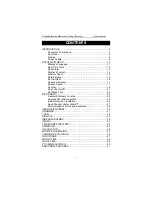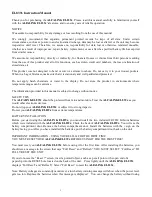
Program P3: Filter 3–5: Filter2
71
3–4d: Time Modulation
These settings let you use three different AMS sources
to control the Time parameters of the EG. For each of
the three AMS sources, the Attack, Decay, Slope, and
Release times each have their own modulation
intensities.
Filter EG Time Modulation
AMS1
[List of AMS Sources]
Selects the first AMS source to control the EG’s Time
parameters. Velocity and Keyboard Track can both be
useful here, for instance.
For a list of AMS sources, see “AMS (Alternate
Modulation Source) List” on page 967.
Attack
[–99…+99]
This controls the depth and direction of the AMS
modulation for the Attack time.
For example, if you set the AMS source to Velocity and
set Attack to +99, the Attack time will get much longer
at higher velocities. If you instead set Attack to –99, the
Attack time will get much shorter at higher velocities.
When the AMS source is at its maximum value–for
instance, when Velocity is at 127–a setting of +8 will
make the Attack time almost twice as long, and a
setting of –8 will cut the Attack time almost in half.
Decay
[–99…+99]
This controls the depth and direction of the AMS
modulation for the Decay time.
Slope
[–99…+99]
This controls the depth and direction of the AMS
modulation for the Slope time.
Release
[–99…+99]
This controls the depth and direction of the AMS
modulation for the Release time.
AMS2 and AMS3
These select the second and third AMS sources,
respectively, for controlling the EG’s Time parameters.
Each has its own intensities for Attack, Decay, Slope,
and Release. The parameters of both AMS2 and AMS 3
are identical to those of AMS1, above.
▼
3–4: Page Menu Commands
The number before each command shows its ENTER +
number-key shortcut. For more information on these
shortcuts, see “ENTER + 0-9: shortcuts for menu
commands” on page 138.
• 0:
Write Program
. For more information, see “Write
• 1:
Exclusive Solo
. For more information, see
• 2:
Copy Oscillator
. For more information, see
“Copy Oscillator” on page 144.
• 3:
Swap Oscillators
. For more information, see
“Swap Oscillator” on page 144.
• 4:
Sync Both EGs
. For more information, see “Sync
3–5: Filter2
This page controls Oscillator 2’s basic filter settings. It
is available only when the
Oscillator Mode
is set to
Double
; if not, the page will be grayed out.
The parameters are identical to those for Oscillator 1,
as described under “3–1: Filter1,” on page 60.
3–6: Filter2 Modulation
This page controls Oscillator 2’s filter modulation. It is
available only when the
Oscillator Mode
is set to
Double
; if not, the page will be grayed out.
The parameters are identical to those for Oscillator 1,
as described under “3–2: Filter1 Modulation,” on
page 63.
3–7: Filter2 LFO Modulation
This page controls Oscillator 2’s LFO filter modulation.
It is available only when the
Oscillator Mode
is set to
Double
; if not, the page will be grayed out.
The parameters are identical to those for Oscillator 1,
as described under “3–3: Filter1 LFO Modulation,” on
page 67.
Note-on
Note-off
Note-on
Note-off
Note-on
Note-off
AMS=Velocity, Intensity = a positive (+) value
“Attack”=+, “Decay”=+,
“Slope”=+, “Release”=+
Softly played note.
Original Shape
“Attack”=+, “Decay”=+,
“Slope”=+, “Release”=+
Stongly played note.
Times are longer.
Reaches Sustainmore
slowly.
“Attack”=–, “Decay”=–,
“Slope”=–, “Release”=–
Stongly played note.
Times are shorter.
Reaches Sustainmore
quickly.
Содержание Electronic Keyboard
Страница 1: ...Parameter Guide Parameter Guide ...
Страница 2: ......
Страница 180: ...Program mode EXi 170 ...
Страница 290: ...EXi STR 1 Plucked String 280 ...
Страница 572: ...Sequencer mode 562 ...
Страница 700: ...Global mode 690 ...
Страница 751: ...Insert Effects IFX1 IFX12 Routing 741 Fig 2 3a Fig 2 3b ...
Страница 902: ...Effect Guide 892 ...
















































